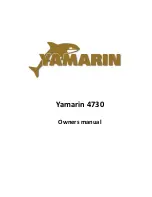
4
Boat Specifications
LOA
: 8.0m or 26.96’/
LOD
: 26’3”
LWL:
20.0’
Beam
: 8’3”
Draft
: 4’10”
Mast Height
: 37’6”
Fuel Tank
capacity
: 4 gallons
Anchor
: Danforth anchor w Rode: Chain is 15’/ line is 200’ twisted nylon marked in 25’
increments (and coiled in two 100’ coils) stowed in plastic tub below companionway.
Engine
: Mercury 4 HP 4 stroke outboard
Accommodations
: Sleeps 2 in the V-berth (dbl)
Instrumentation
: None
Sails
: Main Sail w reef, roller furling genoa/jib, asymmetrical spinnaker.
Summary of Contents for J-80
Page 1: ...1 J 80 Uproar Welcome Aboard Quick Start Guide Boat Manual ...
Page 9: ...9 ...
Page 11: ...11 Sails and Rigging ...
Page 20: ...20 ...





































